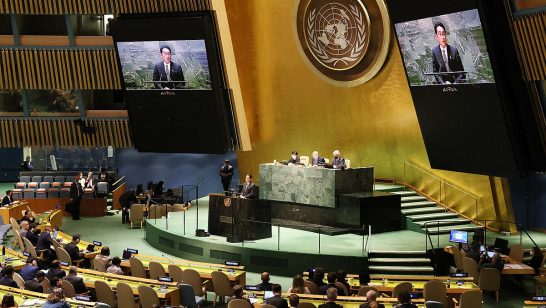
“It is now high time to move from words to action” said Sebastian Kurtz, the Austrian Minister of Foreign Affairs, when opening the Vienna conference on the Humanitarian Impact of Nuclear Weapons on 8–9 December 2014. The conference, organized in the historical Hofburg Palace, was the third in a series devoted to deepening the international community’s understanding of the use of nuclear weapons. But behind the conference’s official fact-finding purpose loomed the question of what to do with the empirics collected in Oslo in March 2013 and Nayarit in February 2014. Do the non-nuclear-weapon states have to wait for the nuclear-armed states to eliminate nuclear weapons? Or can they engage in prohibiting nuclear weapons themselves?
According to the International Campaign to Abolish Nuclear Weapons (ICAN), 44 states called for a legally binding instrument to prohibit nuclear weapons. In addition to increasing support for the idea of a ban, the Vienna conference also saw some more sceptical states sticking their necks out more than they had before. Vienna also saw the emergence of two camps more clearly than in previous conferences: those in favour of the starting of negotiations on a treaty banning nuclear weapons regardless of whether the nuclear-armed states like it or not, and those against.
Whilst the camp in favour of a ban was mad up of a diverse group of countries from all regions and levels of economic development, the countries in the opposing camp, perhaps obviously, all shared the trait of being either nuclear-armed or under nuclear umbrellas. As is well known, European and other western countries constitute the vast majority of the latter group. One challenge for the Humanitarian Initiative will therefore be to remain dedicated to its cause and refrain from ending up in old “trenches” where typically the Non Aligned Movement and the West (with the US at its chief advocate) use the nuclear weapons issue as a vehicle for what is really a predictable “north-south dispute”.
Testament to the initiative’s growing momentum, 158 states attended the latest conference, making it better attended than the last NPT Preparatory Committee meeting (117 delegations) and the earlier humanitarian conferences in Oslo (128) and Nayarit (146). Civil society also showed up in great numbers as did a range of international organizations. Four nuclear-armed states also attended the conference: Pakistan, India, the United States and the United Kingdom. While the former two attended the earlier conferences in Oslo and Nayarit, Vienna was the first time the two P5 countries engaged with the humanitarian initiative.
The first session of the conference featured two panels on the humanitarian consequences of nuclear weapons, recapping and expanding from the two previous conferences. The gendered impacts of nuclear weapons were a welcome addition to the discussion.[1] Hiroshima survivor Setsuko Thurlow spoke about her experiences on 6 August 1945, and three people gave testimonies about the effects nuclear weapons testing had had on them and their communities, including Sue Haseldine, who was a victim of atmospheric nuclear weapons testing by the UK in Australia in the 1950’s. Michelle Thomas from Utah, herself a sufferer of multiple cancers due to US testing, spoke passionately about her nation’s practice of testing without taking precautions for the local population.
When the moderator of this panel opened up to Q&A, having asked that no statements be delivered, the United States was the first to take the floor with a somewhat inexplicable statement about the United States’ unflinching commitment to CTBT (Comprehensive Test Ban Treaty). As many people will know, one of the main reasons that the CTBT is not in force is that the United States has not ratified it. With Ms Thomas’ words still echoing through the palace halls, the US statement seemed slightly out of place.
The second and third sessions featured panels on the risk of nuclear detonations, response capacity, nuclear targeting and nuclear deterrence. As was the case in Norway and Mexico, the clear message from the experts was that in the event of a nuclear detonation, the response capacity of the international community will not be anywhere near good enough, and that the potential to increase said capacity is limited. Nobody in Vienna denied that nuclear weapons must be eliminated once and for all (except the United Kingdom, which vowed to maintain its credible deterrent for as long as it deemed necessary). Yet the recognition that nuclear zero is indeed the goal does not take us very far: that much was agreed in 1968. The question most states are asking themselves now is how long they can wait for more “favourable conditions” to strengthen the nuclear regime. Any distinction between “idealist disarmers” and “nuclear realists” is becoming increasingly untenable. As Eric Schlosser has demonstrated through his thorough investigations of nuclear near-misses, the people pushing for action on disarmament have frighteningly realistic scenarios in mind.
The second day opened with a panel taking a birds-eye view of international law pertaining to nuclear weapons, as well as asking some fundamental moral and ethical questions, such as if the use of nuclear weapons in itself such a horrendous act, does it matter if it works – drawing an analogy to the “ticking bomb” and torture.
More than a 100 states were on the speakers list for the general debate, where a handful of states postulated that “simply banning” nuclear weapons without due recognition for the “security dimension” of nuclear arms would not “guarantee” disarmament.[2] Other umbrella delegations – notably Italy and Germany – similarly alluded that “shortcuts” would not guarantee a world free of nuclear weapons. Yet the delegations most sceptical towards an unconditional ban on nuclear weapons failed to give a persuasive, or even plausible, account of how a ban treaty could harm the goal of a world free of nuclear weapons. Few would argue that any legal instruments guarantee anything, except perhaps for the filling of holes in international law.
The conference was brought to a conclusion with the hosts delivering both a chair’s summary and an Austrian “pledge”. In their pledge the Austrians vowed to deliver the findings of the three humanitarian conferences to the NPT Review Conference in 2015 and to “stigmatise, prohibit, and eliminate nuclear weapons in light of their unacceptable humanitarian consequences and other associated risks.”[3] Next up, the Review Conference.
[1] See Anne Guro Dimmen, “Gendered Impacts”, ILPI and UNIDIR, Vienna Papers, 2014
[2] See for example Canadian Statement to the Vienna Conference on the Humanitarian Impact of Nuclear Weapons, 9 December 2014
[3] Austrian Pledge, Vienna Conference on the Humanitarian Impact of Nuclear Weapons, 9 December 2014
The opinions articulated above represent the views of the author(s), and do not necessarily reflect the position of the European Leadership Network or any of its members. The ELN’s aim is to encourage debates that will help develop Europe’s capacity to address the pressing foreign, defence, and security challenges of our time.



